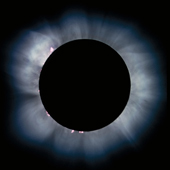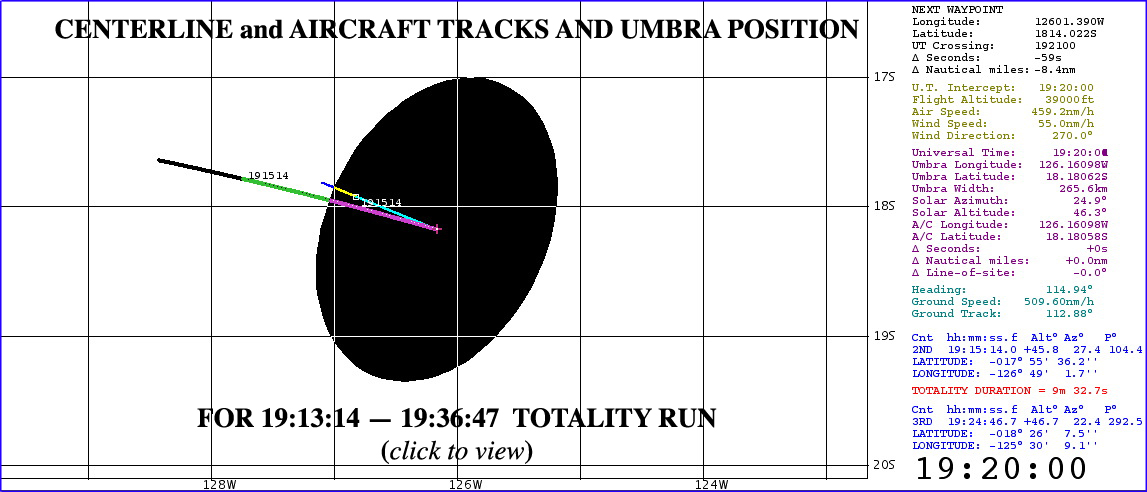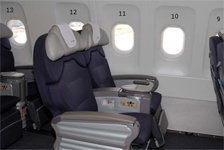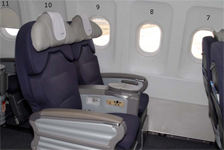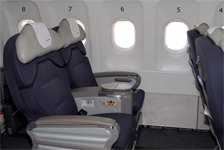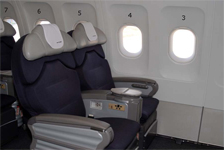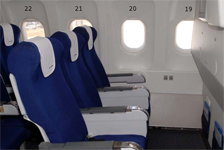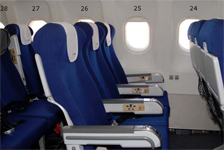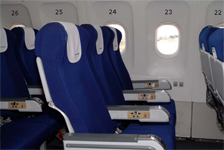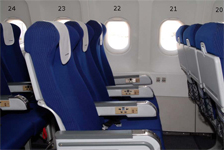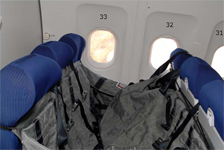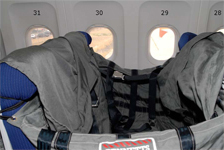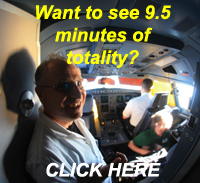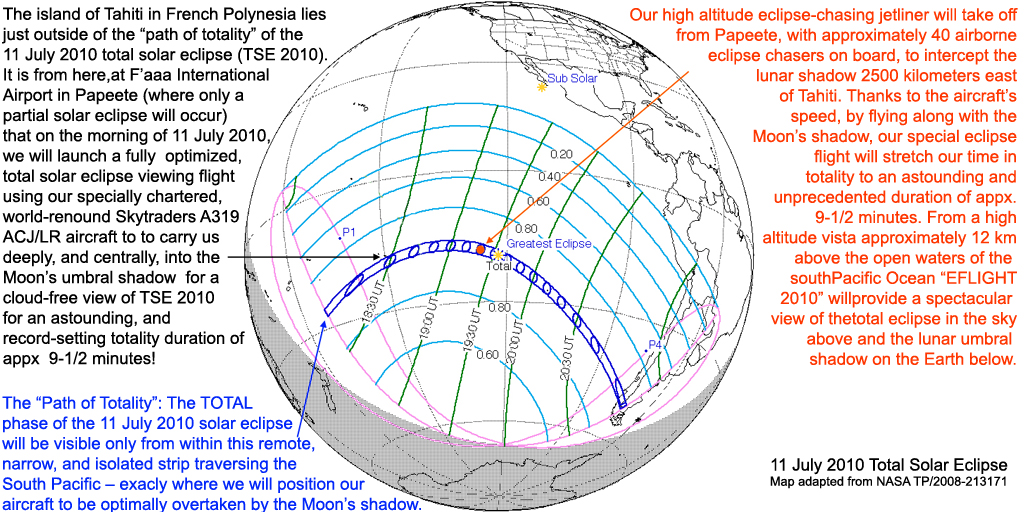
The total phase of the 11 July 2010 solar eclipse will be visible only
from within the "path of totality" — the narrow arc-like strip on the
map above — centered on the southern Pacific Ocean.
(Map source: NASA
TP/2008-213171
by Espenak and Anderson)
Join us in Papeete on our historical sojourn into the Moon's
umbral shadow high above the Pacific Ocean.
How? ---> See
Rick
Brown's EFLIGHT 2010 French Polynesia Web Site <---
Location, Location, Location (it's
all about the weather - and getting ABOVE it!)
Total solar eclipses (TSEs)
are one
of nature's most dramatic and awesome spectacles — but often occur in
remote locations posing logistical (and financial) barriers to
accessibility. The most recent TSE, on 22 July 2009, was visible
from
highly populated areas in India and China, and provided the opportunity
for those who ventured to the point of maximum eclipse in the
Pacific Ocean to view the longest land- or sea-based
total
solar eclipse for more than a century to come. But, many were then
left wondering "what about the NEXT one?" The path of totality
for
the 11 July 2010 solar eclipse soon to be upon us, traverses a vast,
but narrow,
stretch across the south Pacific Ocean (as shown on the map above) —
with landfall
opportunities few
and far between on
only a very small number of sparsely populated islands. Just
moments before sunset umbral landfall occurs in Patagonia, but eclipse
visibility will be problematic in the limited locations there where the
path can be
accessed both because the local climate presents a very high likelihood
of cloud cover and mountains to the west will block many lines-of-sight
to the horizon-hugging setting Sun.
Unfortunately, all along the path of totality,
the chance of TSE 2010 being obscured by cloud is
no better than
about 50/50 even from the "best" locations anywhere on land or
sea.

Comparison of historical July
average cloud obscuration (weighted by sky coverage
and frequency of occurrence) among ground-based, potentially
accessible, observing locations. Climatology data adapted from Jay
Anderson; see
additional data for other longitudes and locations.
|

Comparison of July monthly mean
cloud
cover frequency (percentage of time) as a function of cloud
obscuration, as
compiled by Jay Anderson, for Hao Island and Easter Island.
Easter Island experiences heavy (median 75%) broken
to
fully overcast skies significantly more frequently than Hao Island.
Conversely, and favorably for Hao, lighter, scattered
cloud cover is more
frequent on Hao Island than on Easter Island.
|
BUT: From a
altitude of 39,000 ft. any eclipse-obscuring cloud that may be
present
will be well BELOW the aircraft and of no concern to us.
In addition... the
geometrical and "astrodynamic"
circumstances of the 11 July 2010 total solar eclipse, and upper
atmospheric prevailing July winds in the western South Pacific,
give rise to the
extraordinarily rare opportunity of "chasing" the Moon's shadow with a
commercial jet aircraft giving rise to an astounding duration of
totality of
approximately
nine and a half minutes (!) — historically unprecedented for any
non-military
or non experimental aircraft.
THUS... For Those Who Can Never
Get Enough Totality and
Who Wish Obviate Concerns of Ground-Level Weather:
EFLIGHT
2010 — Umbral immersion for an unprecedented appx 9-1/2 minutes! from
12 km above sea mean level
We
are conducting an unprecedented eclipse viewing flight –
EFLIGHT 2010 – departing from Faaa
International Airport in Papeete on the morning of 11 July 2010, using
the renowned Skytraders Airbus
A319LR/ACJ jet aircraft, on an appx. 7-hour round trip flight into
the path
of totality appx.
2500 kilometers east of Tahiti.
Our
high-altitude aircraft will then take to the skies with up to 41
airborne eclipse chasers* providing
an incredible view of TSE 2010 from ~ 12
km above the south Pacific Ocean. EFLIGHT 2010 will give rise
rise to
an incredibly long duration of totality within the Moon's umbral shadow
of
approximately
nine minutes and a half (!) — unchallenged in the history of civil
sub-sonic
aviation and longer than nature will ever allow for any total solar
eclipse anywhere on the surface of the Earth.
* We are able to accommodate up to 29
(twenty-nine) eclipse-viewing passengers each with their own
window. Alternatively, up to 9 (nine) of those windows MAY be
shared by two people during totality. I.e., we can accommodate up
to eighteen people who, traveling as pairs, who would like to share a
window with a second person sharing a window in pre-arrangement with a
partner.
Look, Ma! – NO SEATS!
All
seats on the left (sun-facing) side of our aircraft will be REMOVED
from the airplane before the flight, giving full, unimpeded,
access to the eclipse-viewing windows, plenty of floor space for
observers, and easy viewing of totality with the Sun appx 46 degrees
above the horizon.
Seating
configuration (for take-off/landing and available during outbound
cruise and inbound return) of our Skytraders Airbus A319LR/ACJ
aircraft.
The sun-facing side of the cabin will be unencumbered by any seat rows,
providing optimal and easy access to the eclipse-viewing windows
totality.
CLICK
HERE for details on the metrology and placement of the windows.
To achieve an extraordinary and unprecedented duration of appx 9-1/2
minutes of
totality, the eclipse will be observed where the altitude
of the Sun during totality will be approximately 46° above the
astronomical horizon. Viewing the eclipse at this relatively high
solar altitude, "half
way
up" the sky, out the aircraft windows will present no problems on our
Skytraders A319 LR/ACJ aircraft, as we have arranged to have
all of the seats (shown above)
on the left (sun facing) side of the
aircraft removed – giving easy and unimpeded access to the floor
below and all spaces around the windows. In this configuration,
window sharing is possible without any crowding for a subset of nine
windows. EFLIGHT 2010 can accommodate up to thirty-eight eclipse
chasers: twenty with a window for themselves alone, while eighteen
others may share one window in partner-pairs.
The Sky Above, The Earth Below –
Totality from 39, 000 feet
Our
high-altitude charter jet aircraft will
provide
a spectacular high-altitude vista to observe totality while
optimally flying along with, and inside of, the Moon's
umbral shadow.
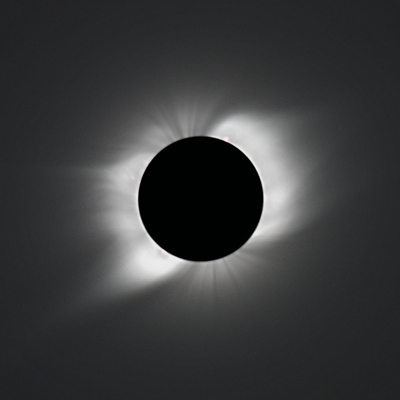
Coronal Structure: B.
Kramer and G. Schneider
(EFLIGHT 2008)
|
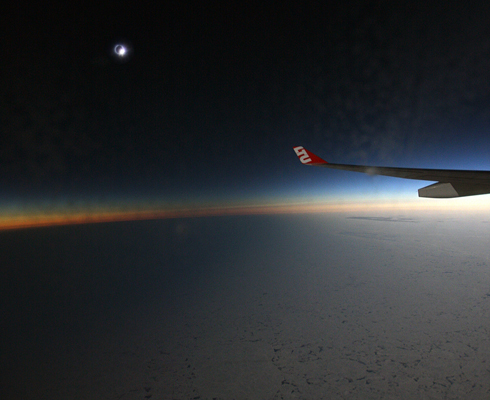
Diamond Ring 11 km above the Earth: D. McGlaun and G.
Schneider
(EFLIGHT 2008)
|

Outer Coronal Streamers
: G. Schneider
(EFLIGHT 2008)
|
Views of totality and the Moon's
shadow on the Earth below and sky above from EFLIGHT 2008 flying at
36,000 feet (within the altitude plan envelope for EFLIGHT 2010).
EFLIGHT
2010 — Baseline Flight Plan
EFLIGHT 2010 will
produce the
longest duration of totality ever observed with a non-experimental or
non-military aircraft in history (a supersonic experimental
Concorde flight in 1973 achieved an astounding 74 minutes in totality —
a record that will continue to stand for quite some time).
With most-likely winds aloft (55 knots from 270°) our anticipated
9m 33s of totality is nearly three minutes longer than the 6m 42s of
totality seen on the Costa
Classica from the point of
maximum eclipse during the recent "big one" on 22 July 2009 (longest
total solar eclipse from the ground for
more than a century to come), and about a two minutes longer
the theoretical maximum of 7m 32s that nature and celestial
mechanics will
ever allow for a ground-based
observer.

Our baseline EFLIGHT 2010 flight scenario, discussed
below, is schematically illustrated on the map above (click on map to
see larger version).
EFLIGHT 2010 will provide a
spectacular opportunity for viewing both the total phase of the eclipse
itself, and the onrush and recession of the Moon's shadow from a vista
with a reach of nearly 400 km to the horizon. To provide optimal
viewing of both the sweep of the umbral shadow over the Earth and of
totality itself, our baseline flight plan is (conceptually) divided
five
segments as depicted on the map above: the outbound and inbound
"cruise" segments of the flight to and from Papeete (purple
segments),
viewing of the approach and recession of the Moon's shadow (green
segments; SV = Shadow Viewing), and viewing
of totality (in yellow, extended appx 2 minutes shown in red segments
before and after second and
third contacts, respectively; TR = Totality Run). See below for
more detail (numbering corresponds to blue map above).
(1) Our EFLIGHT 2010
participants board
the aircraft for departure from F'aaa
airport in Papeete at approximately 15:45 UT (5:45 AM local time)
to later rendezvous with the moon's umbral shadow appx 2500 km east of
Tahiti.
(1-2) During the later part of the outbound cruise, first contact and
the partial
eclipse ingress phase can be viewed out the aircraft left
side windows.
(2) After
traveling eastward from Tahiti for approximately three hours, at
appx. 15
minutes
before
second contact, the aircraft will execute a left hand turn a few
minutes before
the Moon's shadow begins to appear over the appx 388 km distant horizon
(points SV1 for the umbra and aircraft positions as shown in the
illustration below).
(2-3) The projection of the "shadow ellipse" on ground will have its
major (longer) axis pointed toward the Sun and it's minor (smaller)
axis essentially toward the aircraft. As the aircraft flys toward
centerline over the next appx 13 minutes, the approaching shadow in the
sky above, and projected on the Ocean (or clouds) below, will be viewed
directly out the main cabin left-side (eclipse viewing) windows.
(3) At approximately 3-1/2 minutes before second contact, the aircraft
will
execute a 90-degree right hand turn (SV2 – TR1) to put the Sun, at the
completion
of this appx 1.4 minute maneuver (see detailed chronology below),
straight out the eclipse-viewing windows,
and the approaching shadow edge (with its closest point about 55 km
from the aircraft) will be seen "to the left" soon to envelope the
aircraft from "behind".
(3-6) Our aircraft will then be on an optimum trajectory for viewing
totality,
(3-4) and for approximately a minute and a half before "second
contact", the last stages of the ingress phase of the partial eclipse
leading up the start of totality will be viewed straight out the left
side windows.
(4) At
second contact (19:15:14 UT) the leading edge of the umbra will
overtake the aircraft and a glorious diamond ring effect (see middle
picture above from EFLIGHT 2008) will be prolonged by the aircraft's
speed relative to the Moon's shadow.
(4-5) The aircraft will fly through the Moon's umbral shadow for
approximately 9-1/2 minutes, with the aircraft on centerline and
located centrally
in the Moon's shadow at 19:20 UT when it will be most deeply immersed
in the lunar umbra giving spectacularly high contrast views of the
solar corona
from approximately 39,000 feet.
(5) Third contact and TSE 2010 is over with a parting
diamond ring, and a total solar eclipse and observation flight for the
record books with
approximately
9-1/2 minutes of totality observed!
(5-6) The thin sliver of the returning solar crescent waxes and is
viewed for the next appx. minute and a half.
(6) As the Moon's shadow heads eastwards, the aircraft will then
execute another 90-degree right had turn (TR2 – SV3),
(6-7) to give us another spectacular view for the next appx. 10
minutes as the receding shadow whisk its way toward
southern
South America before returning to space.
(7) We then execute a final right
hand turn (at SV4) to begin our approximately three hour westward
return flight
back to Papeete, to join those in Tahiti who had witnesses only a 99%
partial eclipse (8).
E
FLIGHT 2010 —
11 JULY 2010 TOTAL
SOLAR ECLIPSE AT 19:20 UT
Baseline flight scenario: FL 390, Mach
0.80
(TAS 459.2 nm/hr). Statistical wind of 270°/55 kts assumed
for Totality Run only.
|
U.T.
|
Long.
|
Lat.
|
Bearing°
|
Dist
dist(nm)
|
Leg
time
|
Alt° |
Az° |
Est.
Latest
Wheels-Up Papeete
|
15:44:50
|
149°
36' 41" W
|
17°
32" 24"S
|
98.16
|
0.0
|
|
|
|
Est.
Climb to FL 390 (TBD)
|
|
|
|
|
156.0
|
24m
00s
|
|
|
Start
Outbound Cruise
|
16:08:50
|
146°
54' 45" W
|
17°
53' 31" S
|
98.15
|
|
|
|
|
OUTBOUND
CRUISE
|
|
|
|
|
1072.9
|
2h
20m 11s
|
|
|
Est.
1st Contact
|
(17:26:08)
|
(140°
34' 40"W)
|
(18°
33' 04" S)
|
|
|
|
18.2
|
58.2
|
CONTINGENCY "BUFFER" TIME
MARGIN FOR WINDAGE/
DELAY (Est) |
|
|
|
|
|
30m
(TBD)
|
|
|
End
Outbound Cruise
|
18:59:01
|
128°
08' 01" W
|
19°
15' 27" S
|
91.31
|
|
|
|
|
63.4°
Constant Radius Left Turn
Center
TBD: 25° bank, 1.0 min,
Rad: 6.4 nm
|
|
128° 04' 37" W
|
19° 09' 54" S
|
|
7.5
|
59s
|
|
|
Start
Ingress Shadow Viewing
|
19:00:00 |
127°
58' 46"
|
19°
13' 08" S
|
27.9 |
|
|
42.4
|
30.2
|
INGRESS
SHADOW VIEWING
|
|
|
|
|
90.6
|
11m
50s
|
|
|
| End
Ingress
Shadow Viewing |
19:11:50
|
127°
14' 16" W
|
17°
52' 41" S
|
27.7 |
|
|
45.3
|
27.7
|
90°
Constant Radius Right Turn
Center
TBD: 25° bank, 1.4 min, Rad: 6.4 nm |
|
127°
08' 03"W
|
17°
55' 07" S
|
|
10.7
|
1m 24s
|
|
|
Totality
Run Start (~ C2 – 2.0 minutes)
|
19:13:14 |
127°
05' 31"W
|
17°
49' 10" S
|
112.2 |
|
|
45.9
|
27.2
|
WANING
SOLAR CRESCENT VIEWING
|
|
|
|
|
17.0
|
2m
00s
|
|
|
2nd Contact
|
19:15:14
|
126°
49' 02" W
|
17°
55' 36" S
|
112.1
|
|
|
45.8 |
27.4 |
TOTALITY
|
|
|
|
|
40.6
|
4m
46s
|
|
|
Mid-Eclipse
|
19:20:00
|
126°
09' 40" W
|
18°
10' 50" S
|
112.2
|
|
|
46.3 |
24.9 |
TOTALITY
|
|
|
|
|
40.6
|
4m
47s
|
|
|
3rd Contact
|
19:24:47
|
125°
30'
09" W
|
18°
26' 08" S
|
112.2
|
|
|
46.7 |
22.6 |
WAXING SOLAR CRESCENT VIEWING
|
|
|
|
|
17.0
|
2m
00s
|
|
|
| Totality
Run End (~ C3 + 2 minutes) |
19:26:47
|
125°
13' 40"W
|
18°
32' 33"S
|
112.2
|
|
|
46.6 |
22.6 |
90°
Constant Radius Right Turn
Center
TBD: 25° bank, 1.4 min, Rad: 6.4 nm |
|
125° 16'
13" W
|
18° 38' 40"
S
|
|
10.7
|
1m 24s
|
|
|
| Start
Egress Shadow Viewing |
19:28:11 |
125°
09' 59" W
|
18°
40' 24" S
|
200.0
|
|
|
46.9
|
19.9
|
EGRESS
SHADOW VIEWING
|
|
|
|
|
76.5
|
10m
00s
|
|
|
| End
Egress
Shadow Viewing |
19:38:11
|
125°
37' 55" W |
19°
53' 07" S |
200.1
|
|
|
|
|
72.1°
Constant Radius Right Turn
Center
TBD: 25° bank, 1.1 min, Rad: 6.4 nm |
|
125° 44' 24" W
|
19° 50' 54" S
|
|
8.6
|
1m 07s
|
|
|
Start
Inbound Cruise
|
19:39:18
|
125°
46' 38" W
|
19°
56' 56" S
|
272.1
|
|
|
|
|
INBOUND
CRUISE
|
|
|
|
|
1213.6
|
2h
38m 34s
|
|
|
Est 4th Contact
|
(20:35:22)
|
(133°
18' 42" W)
|
(19°
31' 40"S)
|
|
|
|
48.1
|
08.0
|
End
Inbound
Cruise
|
22:17:52
|
147°
01' 39" W
|
17°
57' 09"S
|
|
|
|
|
|
Est
Descent
from FL 390
|
|
|
|
|
150.0
|
24m
00s
|
|
|
Est.
Wheels-Down Papeete
|
22:41:22
|
149°
36' 41" W |
17°
32" 24"S |
|
|
|
|
|
|
|
|
|
|
|
|
|
|
TOTAL TIME/DISTANCE
|
|
|
|
|
2912.3
|
06h 56m 32s |
|
|
Notes:
Totality run to place the Sun "straight out" the main
cabin windows at
mid-eclipse.
Wind correction for assumed 270°/55 kt wind during totality run is
+2.9° for a Heading appx
114.9°.
|
|
|
|
Graphical Simulation
of the "Totality Run" (click to view)
Click
on the above picture for a second-by-second graphical simulation of the
umbral centerline
and aircraft tracks
during minute "Totality Run (6 Mb Quicktime file).
EFLIGHT 2010 — Optimization and
Flexibility
As with previous EFLIGHTs, we
remain flexible to modify
the flight plan in real-time,
within
aircraft operating parameters, in reaction to flight
conditions on eclipse day to enable an eclipse-optimized "totality
run". The exact duration of
totality is dependent not only upon the specific geographical location
(and altitude) at which our aircraft will centrally fly through the
Moon's shadow, but also upon the details of its trajectory and its
ground speed that are subject to variable winds.
In baseline flight planning we assume a most-likely wind of 55 kts from
270° based upon the statistical average of historical mid-July
winds
aloft for our 19:20 UT mid-eclipse intercept location at 39,000
ft. We
also adopt a nominal true air speed of Mach 0.80 (459.2 nm/hr @ 39,000
ft), in the middle of the operational range of the A319 LR/ACJ
aircraft, for greatest flexibility for in situ optimization based upon
the actual winds aloft.
Given the above planning assumptions, we can expect a duration of
totality for a 19:20 UT intercept of appx. 9m 33s. If in flight
constraints and conditions permit, we could increase our true airspeed
to Mach 0.82 (470.4 nm/hr) in which case the duration of totality would
increase to 9m 42s. In the statistically unlikely case of a "no
wind"
condition, and at a mid-operational air speed of Mach 0.80, totality
would be reduced to "only" 8m 58s.
Totality runs with other mid-eclipse intercepts can be built and be
executed on an as-needed contingency-only basis. Mid-eclipse
intercepts earlier in time than 19:20 UT would reduce the achievable
duration of totality to less than 9m 33s (with statistically
most-likely winds and true airspeed of Mach 0.80), and later times up
to ~ 19:30 UT would slightly increase
the
achievable duration of totality but with a diminishing time and cost
vs. duration trade (see table below). At this time, the
19:20 UT
mid-eclipse intercept scenario is
baselined.
EFLIGHT 2010 — ACHIEVABLE DURATION
FOR A SUBSET OF ALTERNATE
MID-ECLIPSE INTERCEPTS (FL390, Mach 0.80, wind 55 kts from 270°)
UT
mid-eclipse
|
Totality
Duration
|
Alt° |
Az° |
Long.
|
Lat.
|
19:10
|
08m 54.0s
|
44.3
|
32.4
|
129° 31'
50" W
|
17° 26'
36" S
|
19:15
|
09m 16.1s
|
45.4
|
28.7
|
127°
49' 07" W
|
17°
46' 22" S
|
19:20
|
09m
32.7s
|
46.3
|
24.9
|
126°
09' 40" W
|
18°
10' 50" S
|
19:25
|
09m 41.0s
|
46.8
|
21.0
|
124°
32' 37" W
|
18° 39'
50" S
|
19:30
|
09m 41.6s
|
47.1
|
17.0
|
122°
57' 14" W
|
19°
13' 15" S
|
Our EFLIGHT 2010 Aircraft — The Skytraders
Airbus A319 LR/ACJ


